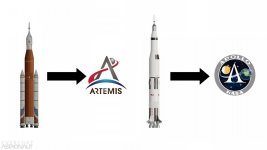Member
Joined 2009
Paid Member
Heavy lift off, there's plenty of missions on the nasa website. Sorry to say I still keep tabs on James Web which is really adding new depths to observations (even with it's issues).
The moon/mars etc missions are excellent as they're really pushing the technology boundaries. I think at some point we'll have a standard probe with changeable payloads (sounds like startrek).
If we're to progress we need new power sources for space travel (only a limited amount of earth originated power sources). Then we need effective energy shielding (stopping small meteorites etc) and then we can start on propulsion. Somewhere along the way we need life-support, food and the obligatory toilet upgrades..
The moon/mars etc missions are excellent as they're really pushing the technology boundaries. I think at some point we'll have a standard probe with changeable payloads (sounds like startrek).
If we're to progress we need new power sources for space travel (only a limited amount of earth originated power sources). Then we need effective energy shielding (stopping small meteorites etc) and then we can start on propulsion. Somewhere along the way we need life-support, food and the obligatory toilet upgrades..
Member
Joined 2009
Paid Member
If you go to the NASA website they have (on one of their pages) a downloadable pdf telling you all about the new Orion space capsule that sits on the top of that rocket - it has upgraded toilets, upgraded heatshields, it's designed to accommodate more people for longer and in more comfort (design parameters were 99% of human body shapes).
I've been reading around on this.
The first two Artemis missions will be testing the command 4 person module that splashes back on Earth.
Artemis 3 will include a 2 astronaut landing module. The top thingie is the lunar takeoff module.

More Space news tonight. The Leonid meteor shower which should be visable after midnight in the East.
Best seen before moonrise.

Promises maybe 200 meteors an hour:
https://www.sciencefocus.com/space/leonid-meteor-shower-2022/
If you don't want to stay up for it, weather permitting, you can watch it tomorrow from Hawaii at midnight, about 10AM UTC:
I watched it this morning. Lots of them. About two a minute. they move at 150,000 mph apparently. That is fast. The Artemis only hits 22.600 mph.
The first two Artemis missions will be testing the command 4 person module that splashes back on Earth.
Artemis 3 will include a 2 astronaut landing module. The top thingie is the lunar takeoff module.
More Space news tonight. The Leonid meteor shower which should be visable after midnight in the East.
Best seen before moonrise.
Promises maybe 200 meteors an hour:
https://www.sciencefocus.com/space/leonid-meteor-shower-2022/
If you don't want to stay up for it, weather permitting, you can watch it tomorrow from Hawaii at midnight, about 10AM UTC:
I watched it this morning. Lots of them. About two a minute. they move at 150,000 mph apparently. That is fast. The Artemis only hits 22.600 mph.
It is like a boosted version of the old ones from the 1970s.
See the size comparison in the attached image.
Did you know that in Greek mythology, Artemis was the twin sister of Apollo and goddess of the moon?
Attachments
There is not a lot in it regarding size of the rockets apart from the boosters.
The boosters give it a bigger payload capacity that has been quoted in buses.
The buses shown in the photo are wrong.
The correct bus standard is a different model. The correct one is in my link.
https://en.wikipedia.org/wiki/File:RM8_AEC_Routemaster.jpg
The boosters give it a bigger payload capacity that has been quoted in buses.
The buses shown in the photo are wrong.
The correct bus standard is a different model. The correct one is in my link.
https://en.wikipedia.org/wiki/File:RM8_AEC_Routemaster.jpg
The Celestial Fireworks were a letdown. I saw one meteor in 20 minutes.
Still shivering from the cold.
Couple of nice illustrations of the Artemis rocket and Orion Lunar podule:

Taller than the Statue of Liberty around 100m, but not as tall as the Eiffel Tower, or (guesses) 20 Red London Double-Decker buses laid end to end. I used to like Bus Spotting. Got about 2,500 of them out of 4,000. A nice day out in London for schoolkids. The boosters crash down into the Ocean. Don't SpaceX do better? The get recycled.
I have environmental concerns about all this Space Junk.

We should get some great photos over the next few days. 4K I expect. It's already half-way to the Moon.
Still shivering from the cold.
Couple of nice illustrations of the Artemis rocket and Orion Lunar podule:
Taller than the Statue of Liberty around 100m, but not as tall as the Eiffel Tower, or (guesses) 20 Red London Double-Decker buses laid end to end. I used to like Bus Spotting. Got about 2,500 of them out of 4,000. A nice day out in London for schoolkids. The boosters crash down into the Ocean. Don't SpaceX do better? The get recycled.
I have environmental concerns about all this Space Junk.
We should get some great photos over the next few days. 4K I expect. It's already half-way to the Moon.
Last edited:
You also have to be careful measuring length in London buses too.
You have to make sure you do not use one with a concertina in the middle of it.😀
https://en.wikipedia.org/wiki/File:Citaro_G_Arriva_London.jpg
You have to make sure you do not use one with a concertina in the middle of it.😀
https://en.wikipedia.org/wiki/File:Citaro_G_Arriva_London.jpg
Eat your heart out Elon with your puny Tesla launch! ;-)The Space Launch System (SLS) is capable of sending more than 27 metric tons (59,000 pounds) to the Moon.
That's more than two London double-decker buses!
jan
They say SLS has got a total thrust of about eight million pounds, in comparison with 'just' seven million Saturn V thrust pounds. Besides that there are quite some more definitions of a pound than just one, what does this mean in SI units?
I watched the SLS launch video yesterday. It somewhat remembered the Saturn V launches >50 years ago that I recall very well. The main difference appears to be that the rocket lifted off almost immediately after the engines' ignition, while the five Saturn V Rocketdyne F-1 engines required a nine second well orchestrated ignition sequence.
Best regards!
I watched the SLS launch video yesterday. It somewhat remembered the Saturn V launches >50 years ago that I recall very well. The main difference appears to be that the rocket lifted off almost immediately after the engines' ignition, while the five Saturn V Rocketdyne F-1 engines required a nine second well orchestrated ignition sequence.
Best regards!
It's all quite complicated, but as I understand it, Super Heavy launchers get a Second Stage and payload of so many Tons or Tonnes. into LEO, which is Low Earth Orbit.
The Second stage and payload then take over the job of getting even higher, like the Moon or Mars.
Looks like Elon's Starship and NASA projected SLS Cargo are the current leaders. Starship is quite a different all-in-one idea from the others.
SpaceX's rockets have reduced capacity when being relanded rather than jettisoned. Hope I got that right.

All quite hard to follow! 😕
The Second stage and payload then take over the job of getting even higher, like the Moon or Mars.
Looks like Elon's Starship and NASA projected SLS Cargo are the current leaders. Starship is quite a different all-in-one idea from the others.
SpaceX's rockets have reduced capacity when being relanded rather than jettisoned. Hope I got that right.
All quite hard to follow! 😕
I think what we've seen yesterday actually was a SLS Block 1 launch. A manned moon landing requires the SLS Block 1B Crew version which is a tiny bit (30 cm) higher than Saturn V and in contrast to this doesn't even carry the moon lander.
Best regards!
Best regards!
Yes, I am starting to get the idea. LEO is getting the rocket into Low Earth Orbit. Then you usually jettison a stage for TLI, Trans Lunar Injection with a 6 minute burn in Apollo's case.
Then you have left the Earth's orbit.

This is where the payload and height confusion sets in.
The SLS is a flexible ongoing project, and part of a bigger one.
Then you have left the Earth's orbit.
This is where the payload and height confusion sets in.
The SLS is a flexible ongoing project, and part of a bigger one.
Better let NASA know they got lucky with the mane being perfect... oh, wait...Did you know that in Greek mythology, Artemis was the twin sister of Apollo and goddess of the moon?
Member
Joined 2009
Paid Member
They have to use multiple stages to efficiently leave the earth's gravity. I don't have the math to hand but it's probably easy to find. What I remember is that the math is relatively simple, we did this math at High School to show that multiple stages were a necessity to reach escape velocity when using liquid/solid fuel rockets. It's all about the ratio of the mass of the fuel to it's energy content in relation to the escape velocity for the earth. The moon, have much less gravity than the earth doesn't require a multi-stage rocket to leave it's surface and return to earth. I wonder if our current technology is even capable of building a rocket that can escape the gravity of larger planets in our solar system.
They say SLS has got a total thrust of about eight million pounds, in comparison with 'just' seven million Saturn V thrust pounds. Besides that there are quite some more definitions of a pound than just one, what does this mean in SI units?
How does almost 40 meganewtons of thrust grab you, Kay?
- Home
- Member Areas
- The Lounge
- Artemis - the NASA mission


